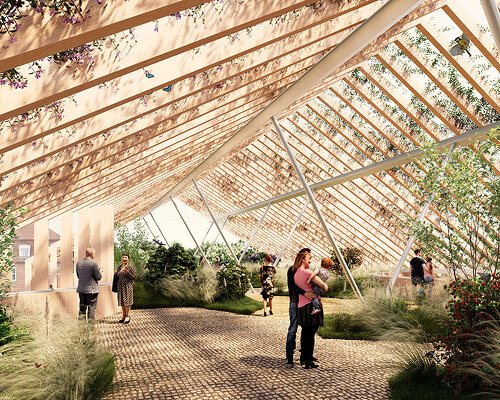a new museum dedicated to photography and contemporary art
Museum Ehrhardt, designed by Francis Kéré, has broken ground in the small village of Plüschow near the Baltic Sea. The work marks the architect’s first cultural project in Germany and his first museum building in Europe. Covering 1,400 square meters, the timber and rammed earth museum is dedicated to photography and contemporary art, with a focus on the work and legacy of Alfred Ehrhardt (1901–1984), a leading figure of the New Objectivity movement, a German modern realist movement which arose in the 1920s as a rejection of romantic idealism.
The site sits beside Schloss Plüschow, a historic castle that now houses an artist residency and gallery. The new museum adds a contemporary layer to this context, engaging with its rural surroundings through material honesty and spatial restraint. Rather than standing apart, the building integrates with the landscape, encouraging a quiet dialogue between past and present.
images © Kéré Architecture
francis kéré’s structure of timber, clay and rammed earth
The architecture of Museum Ehrhardt reflects architect Francis Kéré’s long-standing interest in local craftsmanship and environmentally responsive design. Constructed mainly from timber and clay, the building’s structure is defined by a central rammed earth wall that runs along its main axis. This wall, formed with a rough yet precise texture, anchors the space both physically and atmospherically. It balances humidity and temperature while shaping the rhythm of the galleries.
Above this earthen spine, a timber framework spans the museum’s full width. Designed for future dismantling and reuse, the wooden structure embodies a circular approach to building that prioritizes adaptability and longevity. Developed in collaboration with HK Architekten from Austria, the framework demonstrates a meticulous understanding of material performance and joinery, combining regional craft traditions with forward-looking engineering.
Museum Ehrhardt in Plüschow introduces Francis Kéré’s first museum in Europe
museum ehrhardt’s integration with landscape
The museum’s outer form is defined by a timber pergola that recalls the familiar geometry of rural gable roofs. Its contours trace a vernacular silhouette while allowing the roofline to open toward the surrounding fields and sky. A roof garden extends across the upper level, acting as a biotope that visually and ecologically binds the museum to its setting.
At ground level, a garden unfolds from the museum café, designed with subtle topographical shifts that guide rainwater into collection areas. This system reduces dependence on external water sources and supports the vegetation that softens the building’s perimeter. The landscape and architecture are conceived as one continuous surface, each of which supports the other through an economy of means.
Francis Kéré’s design language remains calm and tactile. Clay, timber, and rammed earth create a sense of groundedness appropriate to the rural setting, while the open layout encourages fluid movement between interior and exterior spaces.
a timber framework designed with HK Architekten allows for future reuse
a central rammed earth wall defines the spatial rhythm of the exhibition halls
the wall’s thermal mass stabilizes humidity and temperature throughout the building
the roof garden functions as a living biotope integrated into the rural landscape
wood and clay construction connects the museum to northern Germany’s craft traditions
rainwater collection shapes the garden’s topography and irrigation strategy
project info:
name: Museum Ehrhardt | @everhartmuseum
architect: Diébébo Francis Kéré | @kerearchitecture in cooperation with HK Architekten | @hk.architekten
location: Plüschow, Germany
status: broken ground
photography: © Kéré Architecture
design team: Leonne Vögelin, Mathis Zondler
contributors: Andrea Maretto, Daniel Melendez, Gökçe Senol, Gudrun Müller, Klara Johnsson, Oskar Haushofer, Benjamin Gabler, Carolin Ackermann, Lara Schöllhorn
partners: Engineering: Merz Kley & Partner GmbH
fire safety: Fire & Timber Ing.
building services: Knecht Ingenieure
building physics: Hafner Weithas Bauphysik
lighting design: Bernd König Lichtplaner
landscape: Erik Dhont Landscape Architects
project management: GAPP GmbH, Antony Gross, Felix Bodenmüller
client: Dr. Jens Ehrhardt, Elke Weicht-Ehrhardt
The post francis kéré arrives in northern germany with timber and rammed earth museum ehrhardt appeared first on designboom | architecture & design magazine.

